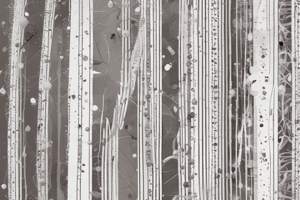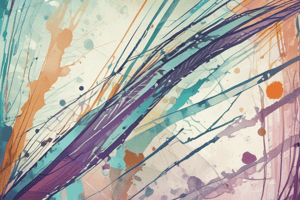Podcast
Questions and Answers
What is the purpose of using specific antibodies in Western blot analysis?
What is the purpose of using specific antibodies in Western blot analysis?
- To transfer proteins to a nitrocellulose membrane
- To detect and bind to the protein of interest (correct)
- To stain all proteins after SDS-PAGE
- To produce a signal captured on film
What is the role of a chemiluminescent substrate like ECL in Western blot analysis?
What is the role of a chemiluminescent substrate like ECL in Western blot analysis?
- Bind and detect the protein of interest
- Transfer proteins to a nitrocellulose membrane
- React with the HRP conjugated secondary antibody to produce a signal captured on film (correct)
- Deposit a colored product on the membrane near the antibody
Which type of substrate can be used to deposit a colored product on the membrane in Western blot analysis?
Which type of substrate can be used to deposit a colored product on the membrane in Western blot analysis?
- Chemiluminescent substrates like ECL
- Chromogenic substrates (4-chloronaphthol or DAB) (correct)
- Specific antibodies against the protein of interest
- Fluorescent-conjugated secondary antibodies
How are proteins identified in Western blot analysis?
How are proteins identified in Western blot analysis?
What does Coomassie stain do in SDS-PAGE?
What does Coomassie stain do in SDS-PAGE?
How can a colored product be deposited on the membrane in Western blot?
How can a colored product be deposited on the membrane in Western blot?
What is transferred to a nitrocellulose membrane in Western blot analysis?
What is transferred to a nitrocellulose membrane in Western blot analysis?
Flashcards are hidden until you start studying
Study Notes
Western Blotting
- Western blotting, also known as immunoblotting, is a technique used to identify one specific protein in a sample containing many proteins.
- The technique involves separating proteins by gel electrophoresis, transferring them to a membrane, and then detecting the protein of interest using a specific antibody.
Steps of Western Blotting
- Step 1: Sample Preparation - involves lysing cells or tissue samples to release proteins, measuring protein concentration, and treating samples with agents to break higher-level structures.
- Step 2: Gel Electrophoresis - separates proteins based on their molecular weight using SDS-PAGE (Sodium Dodecyl Sulfate Polyacrylamide Gel Electrophoresis).
- Step 3: Protein Transfer - transfers proteins from the gel to a membrane, such as nitrocellulose or polyvinylidene fluoride (PVDF), using an electric field.
- Step 4: Immunodetection - uses specific antibodies to detect the protein of interest on the membrane.
Preparing Samples for Electrophoresis
- Lysis buffer should be ice-cold and freshly-made, and protease inhibitor cocktail should be added to the buffer prior to lysis.
- The lysis buffer should be chosen based on the cellular localization of the protein of interest.
- Whole cell lysis buffer: NP-40 or RIPA; Cytoplasmic (soluble): Tris-HCl; Cytoplasmic (cytoskeletal bound): Tris-Triton; Membrane bound: NP-40 or RIPA; Nuclear: RIPA; Mitochondria: RIPA.
Reducing and Denaturing
- Reducing agents, such as β-mercaptoethanol or DTT, are used to break disulfide bonds and expose binding sites for the antibody.
- Denaturing agents, such as SDS, are used to break higher-level structures and coat proteins with negative charges at a uniform mass ratio.
- Note: Some antibodies only recognize non-reduced and/or non-denatured protein, so SDS and/or β-mercaptoethanol or DTT should be removed from buffers.
SDS-PAGE
- SDS-PAGE is a method to separate individual proteins from one another in an electric field according to electrophoretic mobility.
- Proteins are covered by SDS (negative charges) at a uniform mass ratio, so endogenous protein charges are negligible.
- Smaller proteins are less inhibited by the matrix and move more quickly.
- Gels can be made of different percentages of acrylamide to separate proteins of different sizes.
Protein Transfer
- The principle of protein transfer is similar to PAGE, where negatively charged proteins migrate toward the cathode in an electric field.
- A membrane is sandwiched between the gel and the cathode, and proteins adhere to the membrane in the same pattern as in the gel.
Immunodetection
- Antibodies are used to detect the protein of interest on the membrane.
- Detection methods include chemiluminescent substrates, chromogenic substrates, and fluorescent-conjugated secondary antibodies.
- Examples of antibodies used in Western blotting: Ab8226, Ab94303, Ab89345.
Studying That Suits You
Use AI to generate personalized quizzes and flashcards to suit your learning preferences.




